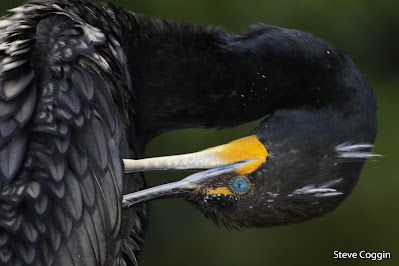 |
| Tricolored Heron (Egretta tricolor). Green Cay Wetlands. Palm Beach County, Florida |
Birds are hard to photograph. Many are small, actively moving and distant. But sometimes, in some places, you can get close looks and even closeup photos, bird portraits.
 |
| Great Egret (Ardea alba). Green Cay Wetlands. Palm Beach County, Florida. |
The most striking feature in bird portraits is usually the eyes. Different species have a different look to
their eyes. Herons and egrets have keen,
piercing eyes. They are eyes of vicious
predators that weigh only a few pounds.
Pigeons have the eyes of prey, constantly looking for their predators
that can come from any direction.
 |
| White Ibis (Eudocimus albus). Wakodahatchee Wetlands. Palm Beach County, Florida. |
 |
| Rock Pigeon (Columba livia). Green Cay Wetlands. Palm Beach County, Florida. |
 |
| Boat-tailed Grackle (Quiscalus major). Wakodahatchee Wetlands. Palm Beach County, Florida. |
Another feature that stands out in portraits of birds is the beak. The beak is made of the protein keratin, the same structural element in hair, hooves and claws. Keratin allows the beak to be strong and light. Beaks take on some of the functions of teeth in other animals. Of course, the birds of today do not have teeth. These were lost in evolution to cut down of weight and allow flight. Nostrils are located on the beak and are mostly is used for breathing. The sense of smell is greatly reduced in birds. They lost the olfactory lobes of the brain in another weight saving adaption for flight.
 |
| Double-crested Cormorant (Nanopterum auritum) Wakodahatchee Wetlands. Palm Beach County, Florida. |
 |
| Double-crested Cormorant. Green Cay Wetlands. Palm Beach, Florida. |
 |
| Great Egret. Green Cay Wetlands. Palm Beach County, Florida. |
 |
| Tricolored Heron. Green Cay Wetlands. Palm Beach County, Florida. |
 |
| Juvenile Wood Stork (Mycteria americana). Wakodahatchee Wetlands. Palm Beach County, Florida. |
 |
| Limpkin (Aramus guarauna). Green Cay Wetlands. Palm Beach County, Florida. |
Most mammals have obvious external ears. But even in a closeup view of a bird head the ears are not visible. Birds have hidden ears, covered by feathers. Despite the feather covering, birds have an excellent sense of hearing. They use this fine-tuned sense to communicate with each other, and to detect predators or prey.
 |
| American Coot (Fulica americana). Green Cay Wetlands. Palm Beach County, Florida. |
 |
| Tricolored Heron. Wakodahatchee Wetlands. Palm Beach County, Florida. |
 |
| Great Blue Heron (Ardea herodias). Paynes Prairie. Alachua County, Florida. |
Feathers are the defining feature of birds. They are made of keratin, the same protein the makes up the beak. Feathers cover most of the bird and have many functions including flight, insulation and mating display. The color of feathers ranges from deepest black to pure white and all colors in between. Sometimes the feathers are iridescent and flash with color as the angle of light changes. Some birds have a cryptic feather pattern that acts as perfect camouflage.
 |
| Anhinga (Anhinga anhinga). Green Cay Wetlands. Palm Beach County, Florida. |
 |
| Black-bellied Whistling Ducks (Dendrocygna autumnalis). Green Cay Wetlands. Palm Beach County, Florida. |
 |
| Green Heron (Butorides virescens). Wakodahatchee Wetlands. Palm Beach County, Florida. |
 |
| Cattle Egret (Bubulcus ibis). Wakodahatchee Wetlands. Palm Beach County, Florida. |
 |
| Juvenile Cattle Egret. Wakodahatchee Wetlands. Palm Beach County, Florida. |
 |
| American Bittern (Botaurus lentiginosus). Green Cay Wetlands. Palm Beach County, Florida. |
These images were made at refuges in Florida where people and birds tolerate each other. This allows close interactions that do not stress the birds. Birds are so much like us, and so different. Getting a chance to see birds at close range is real gift.
 |
| Pied-billed Grebe (Podilymbus podiceps). Green Cay Wetlands. Palm Beach County, Florida. |
No comments:
Post a Comment